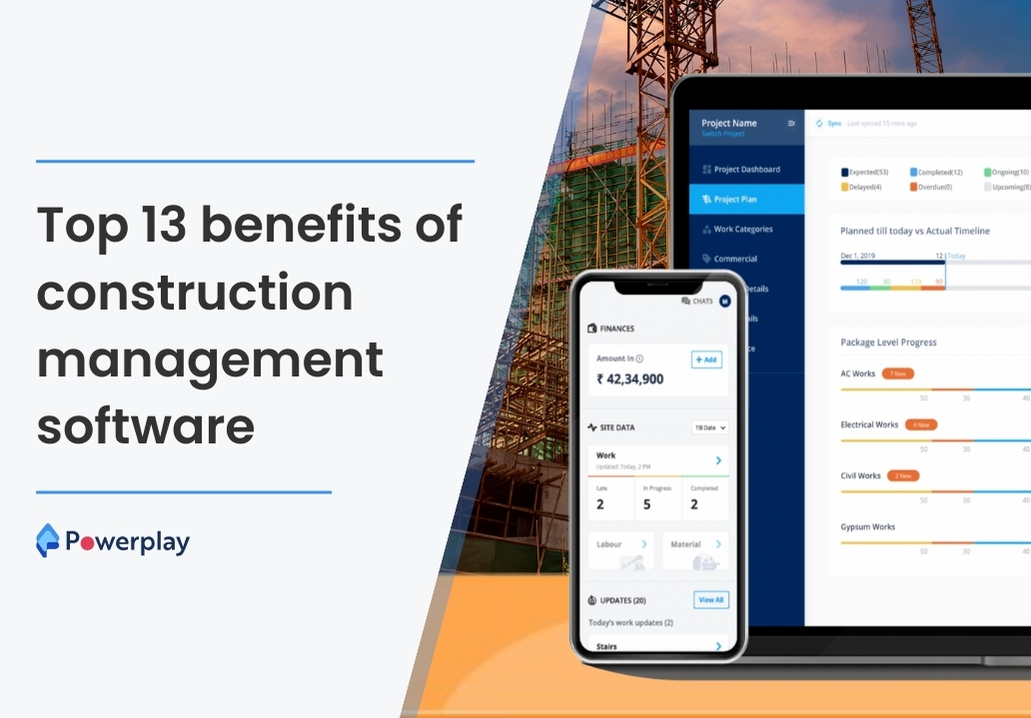Construction Balance Sheet: A How-to Guide for Owners
-
 Dharmesh Dave
Dharmesh Dave
- July 1, 2024

In the construction industry, a well-maintained balance sheet is crucial for a construction company to make informed business decisions and ensure financial stability. Understanding how to read and utilise a construction balance sheet can help owners manage their finances effectively and position their business for long-term success. In this guide, we’ll walk you through everything you need to know about construction balance sheets.
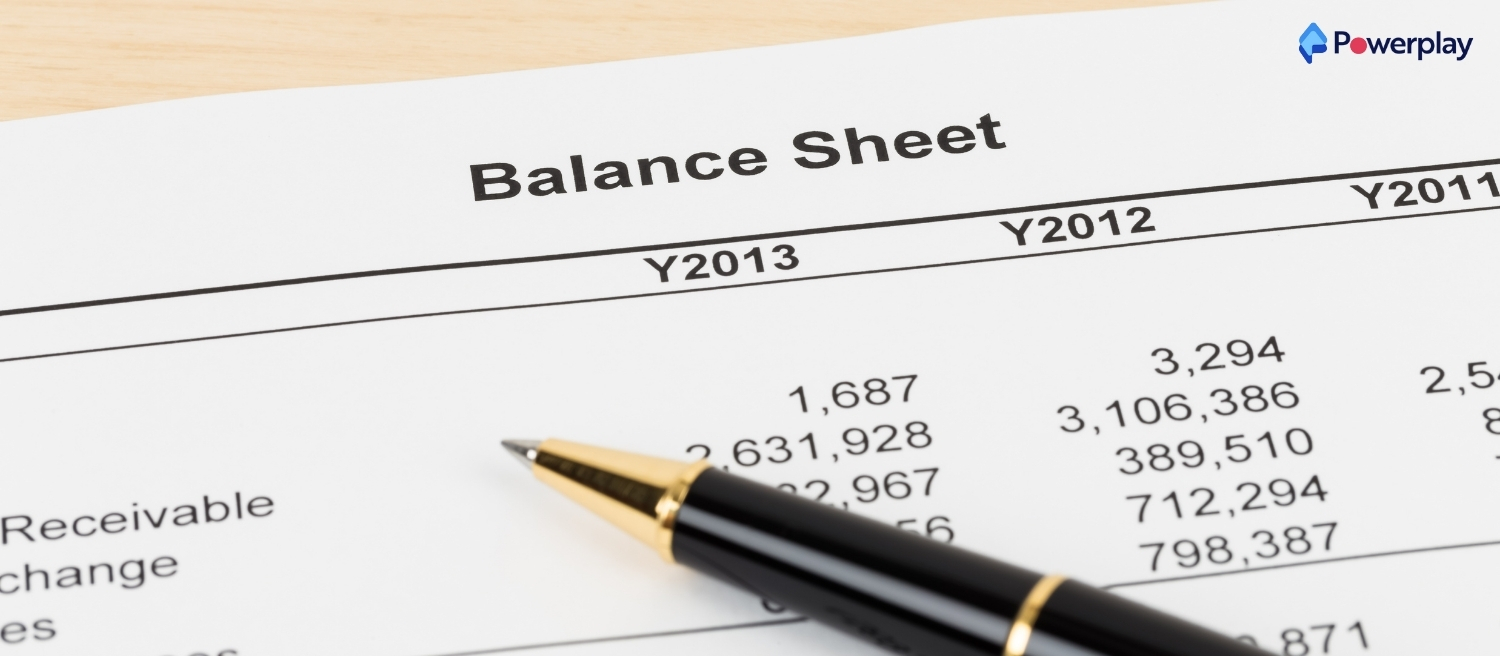
Table of Contents
What is a Construction Balance Sheet?

A construction balance sheet is a financial document that captures a company’s financial status at a particular moment. It details the company’s assets, liabilities, and equity, offering owners a comprehensive understanding of their financial health.
Balance Sheet Basics
To fully grasp the importance of a balance sheet, it’s essential to understand its fundamental components: assets, liabilities, and equity.
Assets
Assets represent everything the company owns that has value. This includes cash, accounts receivable, equipment, and inventory. In a construction balance sheet, assets are typically divided into current assets (cash, receivables, etc.) and non-current assets (property, equipment, etc.).
Liabilities
Liabilities are the amounts the company owes, representing its financial obligations or debts. These can include loans, accounts payable, and other forms of debt. Like assets, liabilities are categorised into current liabilities (due within a year) and long-term liabilities (due after more than a year).
Equity
Equity represents the owners’ claims after all liabilities have been settled. It includes invested capital and retained earnings. In simpler terms, equity is what the company owns outright after paying off its debts.
Understanding the Classified Balance Sheet
A classified balance sheet organises assets and liabilities into subcategories, providing a clearer and more detailed view of a company’s financial position. This format helps owners quickly assess liquidity, solvency, and operational efficiency.
Why the Balance Sheet Matters in Construction
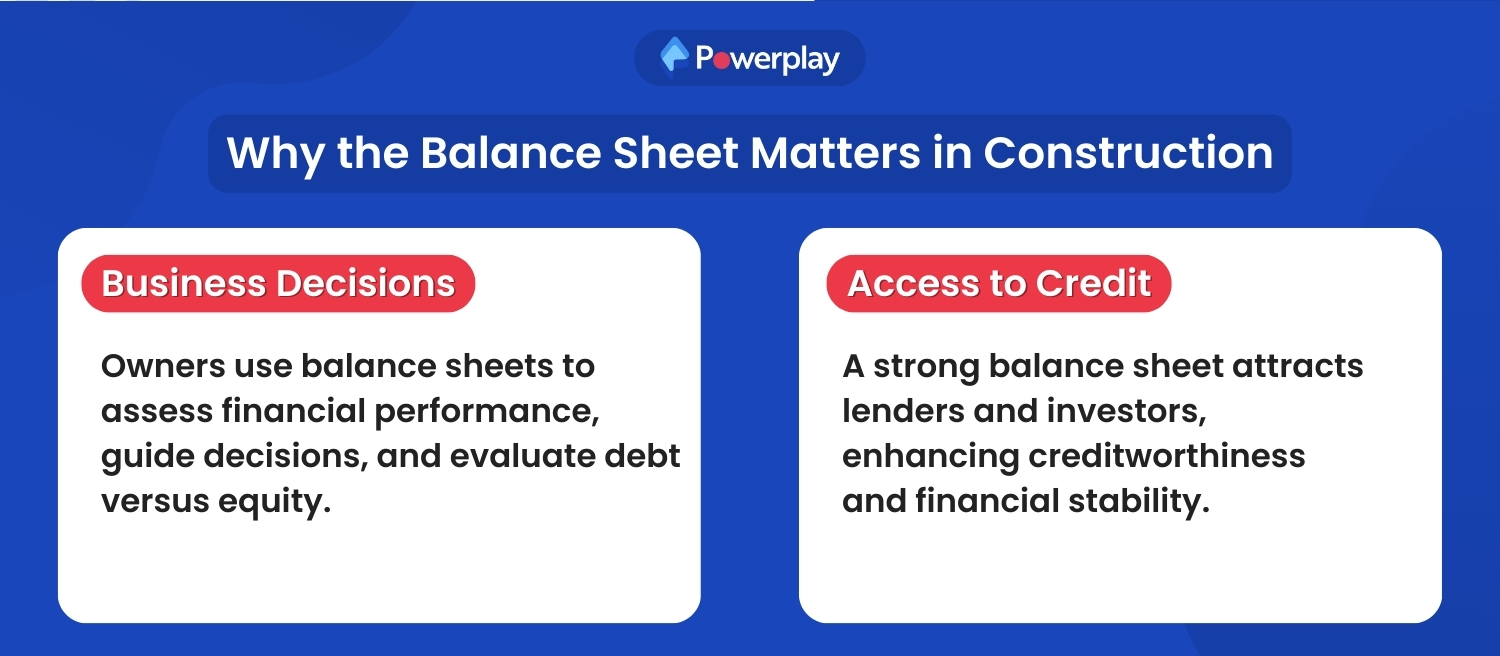
The balance sheet is not just a financial statement; it is indeed a powerful tool for making strategic business decisions and securing credit.
Business Decisions
Owners can use balance sheets to assess the company’s financial performance and make better decisions about growth, investments, and operations. Understanding the company’s financial leverage is crucial for evaluating the amount of debt in relation to equity. By analysing trends and ratios, they can identify strengths and areas needing improvement.
Access to Credit
A strong balance sheet can boost a company’s ability to obtain credit. Lenders and investors often review balance sheets to evaluate creditworthiness and financial stability before extending loans or investment opportunities.
How to Read a Balance Sheet to Make Smart Business Decisions
Reading a balance sheet effectively requires more than just glancing at the numbers. A cash flow statement is also crucial for tracking the flow of cash into and out of the business, categorising cash flows into operating, investing, and financing activities. It involves understanding the context and making connections to other financial documents.
Using balance sheets with equipment ledgers
In construction, equipment can be a significant asset. Comparing the balance sheet with equipment ledgers can help owners track the value and depreciation of their machinery, aiding in asset management and future investments.
5 Key Balance Sheet Ratios to Determine Creditworthiness
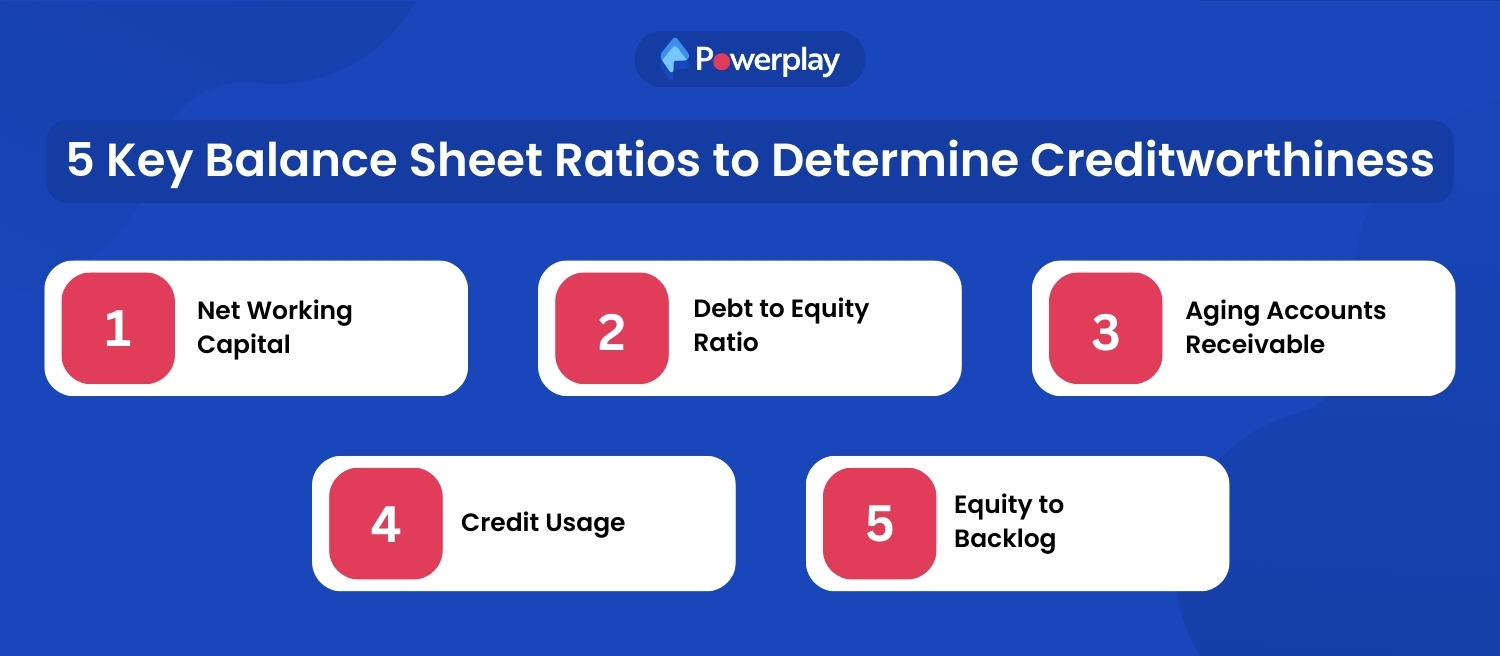
Financial ratios taken from the balance sheet are vital indicators of a company’s creditworthiness and financial health. They provide insight into various aspects of a company’s financial performance, helping owners, lenders, and investors make informed decisions. Here are five key ratios to monitor:
1. Net Working Capital
Net working capital (NWC) indicates how well a company can meet its short-term financial obligations using its current assets. This financial metric is derived by subtracting current liabilities from current assets.
Importance:
- Liquidity Assessment: A positive NWC indicates that a company can cover its short-term liabilities with its short-term assets, reflecting good liquidity.
- Operational Efficiency: High NWC suggests efficient management of receivables, payables, and inventory.
- Financial Health: Consistent positive NWC is a sign of financial stability and operational efficiency.
2. Debt to Equity Ratio
The debt to equity ratio (D/E) assesses the extent to which a company relies on debt versus its own equity for financing. Net income, a part of equity, is either reinvested into the business as retained income or distributed among corporate owners as distributed income. It indicates how much of a company’s operations are funded by debt versus owned capital.
Importance:
- Risk Assessment: A high D/E ratio indicates higher financial risk due to increased reliance on debt.
- Creditworthiness: Lenders often use this ratio to evaluate a company’s borrowing capacity and financial stability.
- Financial Leverage: This ratio helps owners understand the level of financial leverage and the potential return on equity.
3. Aging Accounts Receivable
The aging accounts receivable ratio tracks how long it takes for receivables to be collected. This ratio is crucial for understanding the efficiency of the company’s credit policies and cash flow management.
Importance:
- Cash Flow Management: Faster collections improve cash flow, enabling the company to meet its obligations and invest in growth opportunities.
- Credit Policy Effectiveness: This ratio helps evaluate the effectiveness of the company’s credit policies and customer payment behaviors.
- Liquidity: Efficient receivable management contributes to better liquidity and reduces the risk of bad debts.
4. Credit Usage
Credit usage measures the extent to which a company utilises its available credit. Monitoring this ratio ensures that the company maintains a healthy balance between debt and available credit.
Importance:
- Debt Management: Maintaining optimal credit usage helps prevent over-leverage and financial strain.
- Creditworthiness: Lenders assess credit usage to determine the company’s ability to manage its credit lines effectively.
- Financial Flexibility: Balanced credit usage provides financial flexibility for unforeseen expenses and growth opportunities.
5. Equity to Backlog
The equity to backlog ratio compares a company’s equity to the value of its contracted work that is not yet completed (backlog). This ratio provides insight into the company’s capacity to sustain operations and growth.
Importance:
- Operational Capacity: A higher ratio indicates strong equity support for ongoing and future projects, reflecting operational capacity and stability.
- Growth Potential: This ratio helps evaluate the company’s ability to take on new projects and expand its operations.
- Financial Health: A favorable equity to backlog ratio suggests a healthy balance between equity and contractual obligations, enhancing overall financial health.
The Numbers Tell a Story
Balance sheets provide a narrative about a company’s financial health and trajectory. An income statement, detailing income and expenses over a defined period, is also crucial for calculating net profit or loss and should be used alongside the balance sheet, cash flow statement, and work in progress report to gain a comprehensive view of a business’s financial health.
Stay updated on what’s happening in construction.
Regularly updating and reviewing the balance sheet keeps owners informed about the company’s financial status and helps anticipate future challenges and opportunities.
Balance Sheet Preparation & Review
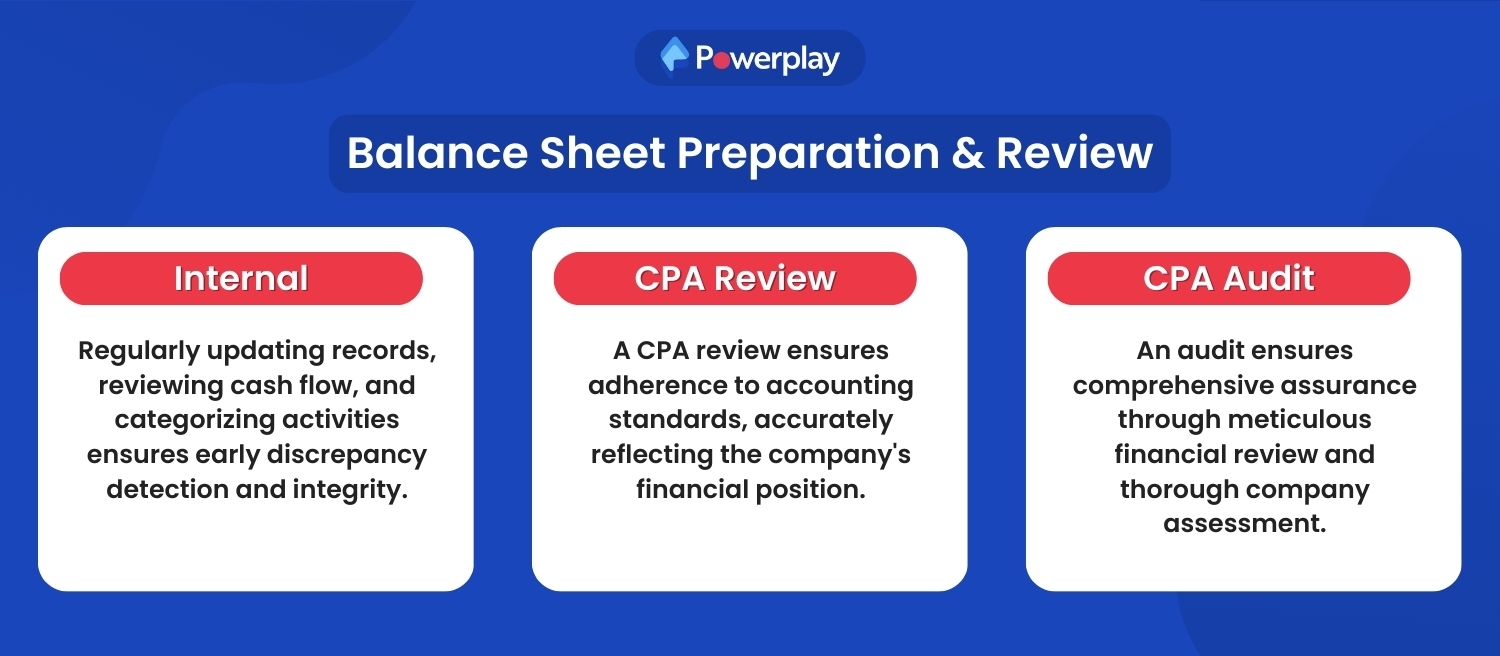
Consistent preparation and review of the balance sheet are crucial for maintaining financial accuracy and compliance.
Internal
Internal preparation involves regularly updating financial records and ensuring accuracy. Reviewing cash flow statements is crucial for tracking the flow of cash into and out of the business, categorising cash flows into operating, investing, and financing activities. This process helps identify discrepancies early and maintain financial integrity.
CPA Review
A CPA review provides an external perspective, ensuring that the balance sheet adheres to accounting standards and accurately reflects the company’s financial position.
CPA Audit
An audit provides the most comprehensive assurance available. It entails a meticulous review of financial records and offers a thorough assessment of the company’s financial well-being.
Best Practices for Construction Balance Sheets
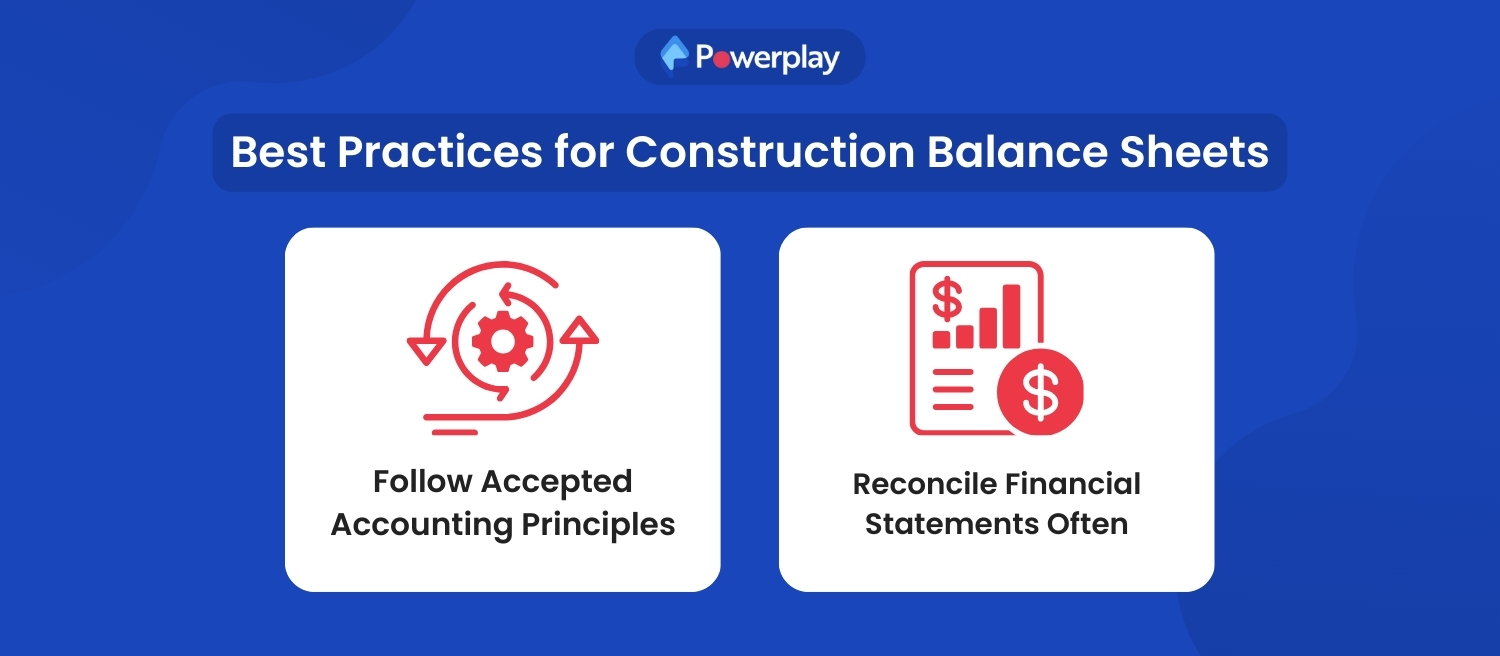
Adhering to best practices ensures the reliability and accuracy of the balance sheet.
Follow accepted accounting principles.
Using Generally Accepted Accounting Principles (GAAP) ensures consistency and comparability in financial reporting.
Reconcile financial statements often.
Regular reconciliation of financial statements helps catch errors and discrepancies, maintaining the integrity of financial data. This process includes tracking fixed assets such as real estate, heavy equipment, and other long-term investments captured in the balance sheet.
Making Balanced Financial Decisions
A well-prepared and accurately interpreted balance sheet is indispensable for construction business owners. Profit and loss statements, also known as income statements, are equally important as they display a business’s revenue and expenses over a specific period of time. By understanding and utilising this financial tool, owners can make informed decisions, secure necessary credit, and steer their companies toward sustained success. Embrace the power of the balance sheet to build a financially sound and prosperous construction business.
Share

Dharmesh Dave is a communications professional with eight years of experience in crafting PR, branded, and marketing content for real estate and construction industries. His passion lies in the art of creative storytelling, making him a zestful force in the field of communication.



